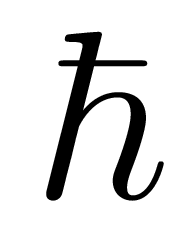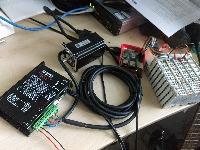Implementing stall protection with closed loop steppers
- minimax
-
 Topic Author
Topic Author
- Offline
- New Member
-

Less
More
- Posts: 8
- Thank you received: 0
10 Nov 2019 11:33 #150050
by minimax
Implementing stall protection with closed loop steppers was created by minimax
Hi all,
I am into the adventure of building a DIY wood router for my workshop, it is already running nicely although I have still plenty to do to bring it into full operation state. In particular, since I have two synchronous motors on the gantry, I badly need to implement a stall protection which would disable all motors in case any of them would stall. Electronics is clearly my weak spot in this project, so I am pretty unsure about my judgment when it comes to wiring's.
In a nutshell, here is my machine setup:
> 3 axis mill with a synchronized gantry (XYYZ joints)
> 4x closed loop steppers and dedicated drivers.
> LinuxCNC controller
> For now I am playing with a cheap BOB, but as soon as I feel ready for it I will switch to a MESA 7i76e.
> PNP proximity switches for homing and limits.
As said above my target is basically to stop all operations if ever one motor stalls. Probably I can use the closed loop encoder signal, but I really don't know what is the "best practice" way to do it. For instance would it be better to relay an error signal to the BOB and trigger an emergency stop, or to wire somehow the four drivers together such that they all share a same "error state"?
I should mention that the drivers have an [alarm+,alarm-] output which is active when in following error state (+ other errors), and a [pending+,pending-] output which is active when "actual position equals command position". There is also an [enable+,enable-] input which is said to be an "NPN control signal", enable is active when high (and when disconnected).
Would it maybe be enough to wire in parallel somehow all drivers [enable] inputs with all [pending] outputs ? Although I am not sure how to do this well...
Thanks in advance for your help,
Cheers
I am into the adventure of building a DIY wood router for my workshop, it is already running nicely although I have still plenty to do to bring it into full operation state. In particular, since I have two synchronous motors on the gantry, I badly need to implement a stall protection which would disable all motors in case any of them would stall. Electronics is clearly my weak spot in this project, so I am pretty unsure about my judgment when it comes to wiring's.
In a nutshell, here is my machine setup:
> 3 axis mill with a synchronized gantry (XYYZ joints)
> 4x closed loop steppers and dedicated drivers.
> LinuxCNC controller
> For now I am playing with a cheap BOB, but as soon as I feel ready for it I will switch to a MESA 7i76e.
> PNP proximity switches for homing and limits.
As said above my target is basically to stop all operations if ever one motor stalls. Probably I can use the closed loop encoder signal, but I really don't know what is the "best practice" way to do it. For instance would it be better to relay an error signal to the BOB and trigger an emergency stop, or to wire somehow the four drivers together such that they all share a same "error state"?
I should mention that the drivers have an [alarm+,alarm-] output which is active when in following error state (+ other errors), and a [pending+,pending-] output which is active when "actual position equals command position". There is also an [enable+,enable-] input which is said to be an "NPN control signal", enable is active when high (and when disconnected).
Would it maybe be enough to wire in parallel somehow all drivers [enable] inputs with all [pending] outputs ? Although I am not sure how to do this well...
Thanks in advance for your help,
Cheers
Please Log in or Create an account to join the conversation.
- tommylight
-

- Away
- Moderator
-

Less
More
- Posts: 21154
- Thank you received: 7223
10 Nov 2019 12:09 #150053
by tommylight
Replied by tommylight on topic Implementing stall protection with closed loop steppers
It looks like the error outputs are optocouplers, so most probably they can be wired in parallel and still function properly, but you loose the ability to know what axis caused the error, for that they do need separate inputs.
Enable inputs can be wired to the same output. Leave the :pending: unconnected as i have no idea what it does.
Enable inputs can be wired to the same output. Leave the :pending: unconnected as i have no idea what it does.
Please Log in or Create an account to join the conversation.
- minimax
-
 Topic Author
Topic Author
- Offline
- New Member
-

Less
More
- Posts: 8
- Thank you received: 0
10 Nov 2019 12:43 #150056
by minimax
Replied by minimax on topic Implementing stall protection with closed loop steppers
If i understand well, the pending output is a logical "not in following error" signal, while :alarm has a wider error scope. Anyway it makes indeed more sens to use the alarm output as a blocking signal.
Still I am not sure how to proceed with the wiring setup since alarm is active high but enable must be pulled down for the driver to be disabled. Should I use a diode circuitry ?
Still I am not sure how to proceed with the wiring setup since alarm is active high but enable must be pulled down for the driver to be disabled. Should I use a diode circuitry ?
Please Log in or Create an account to join the conversation.
- tommylight
-

- Away
- Moderator
-

Less
More
- Posts: 21154
- Thank you received: 7223
10 Nov 2019 12:54 #150057
by tommylight
Replied by tommylight on topic Implementing stall protection with closed loop steppers
Pending seems to be like "not yet in position".
Yes, use the alarm output.
You can use the invert function in Linuxcnc for enable, but that leaves it active until Linuxcnc is started. Using a transistor and resistor in inverter mode is much better, but that will complicate things a bit.
Yes, use the alarm output.
You can use the invert function in Linuxcnc for enable, but that leaves it active until Linuxcnc is started. Using a transistor and resistor in inverter mode is much better, but that will complicate things a bit.
Please Log in or Create an account to join the conversation.
- andypugh
-

- Offline
- Moderator
-

Less
More
- Posts: 19770
- Thank you received: 4599
11 Nov 2019 15:30 #150127
by andypugh
Replied by andypugh on topic Implementing stall protection with closed loop steppers
LinuxCNC has an "amp-fault" pin for each axis.
joint.N.amp−fault−in
linuxcnc.org/docs/2.8/html/man/man9/motion.9.html
This is the place to connect the fault outputs from the drive.
(if you are short of pins, then you can parallel them all in to one input, but then you won't know which joint has stalled)
joint.N.amp−fault−in
linuxcnc.org/docs/2.8/html/man/man9/motion.9.html
This is the place to connect the fault outputs from the drive.
(if you are short of pins, then you can parallel them all in to one input, but then you won't know which joint has stalled)
Please Log in or Create an account to join the conversation.
- theshade
-

- Offline
- Junior Member
-

Less
More
- Posts: 29
- Thank you received: 5
13 May 2020 07:45 #167616
by theshade
Replied by theshade on topic Implementing stall protection with closed loop steppers
Reading this thread, I was asking what this pending or arrival signal was to a closed loop server driver manufacturer and the answer was:
PEND- PEND+
"Arrival output signal: When the difference between the position of pulse command which output from the upper controller and the current position of stepper servo motor is less than the setting data, the arrival signal will be outputted. Then the upper controller receive this signal to confirm the completion of the in position."
How and why would one need these in linuxCNC.. would it be able to impact on the g-command execution or be used in anotherway. or is it just not useable in linuxCNC?
PEND- PEND+
"Arrival output signal: When the difference between the position of pulse command which output from the upper controller and the current position of stepper servo motor is less than the setting data, the arrival signal will be outputted. Then the upper controller receive this signal to confirm the completion of the in position."
How and why would one need these in linuxCNC.. would it be able to impact on the g-command execution or be used in anotherway. or is it just not useable in linuxCNC?
Please Log in or Create an account to join the conversation.
- tommylight
-

- Away
- Moderator
-

Less
More
- Posts: 21154
- Thank you received: 7223
13 May 2020 07:56 #167617
by tommylight
Replied by tommylight on topic Implementing stall protection with closed loop steppers
Most probably that is for use with PLC.
PLC sends the command to move to a preprogramed position and the drive sends back the signal that it arrived at that position, so the PLC has to wait till that signal is in, after that the other stuff can be controlled from PLC.
Just a stab in the dark, so do not take this as the ultimate answer.
PLC sends the command to move to a preprogramed position and the drive sends back the signal that it arrived at that position, so the PLC has to wait till that signal is in, after that the other stuff can be controlled from PLC.
Just a stab in the dark, so do not take this as the ultimate answer.
The following user(s) said Thank You: theshade
Please Log in or Create an account to join the conversation.
- rodw
-

- Offline
- Platinum Member
-

Less
More
- Posts: 11611
- Thank you received: 3905
13 May 2020 08:04 #167621
by rodw
Replied by rodw on topic Implementing stall protection with closed loop steppers
I agree with Tommy. There are many more motors used in industry than in CNC so many controllers have features to run in an industrial sense but the motion control features are not used with Linuxcnc becasue Linuxcnc IS THE MOTION CONTROLLER
The following user(s) said Thank You: tommylight, theshade
Please Log in or Create an account to join the conversation.
Time to create page: 0.067 seconds
